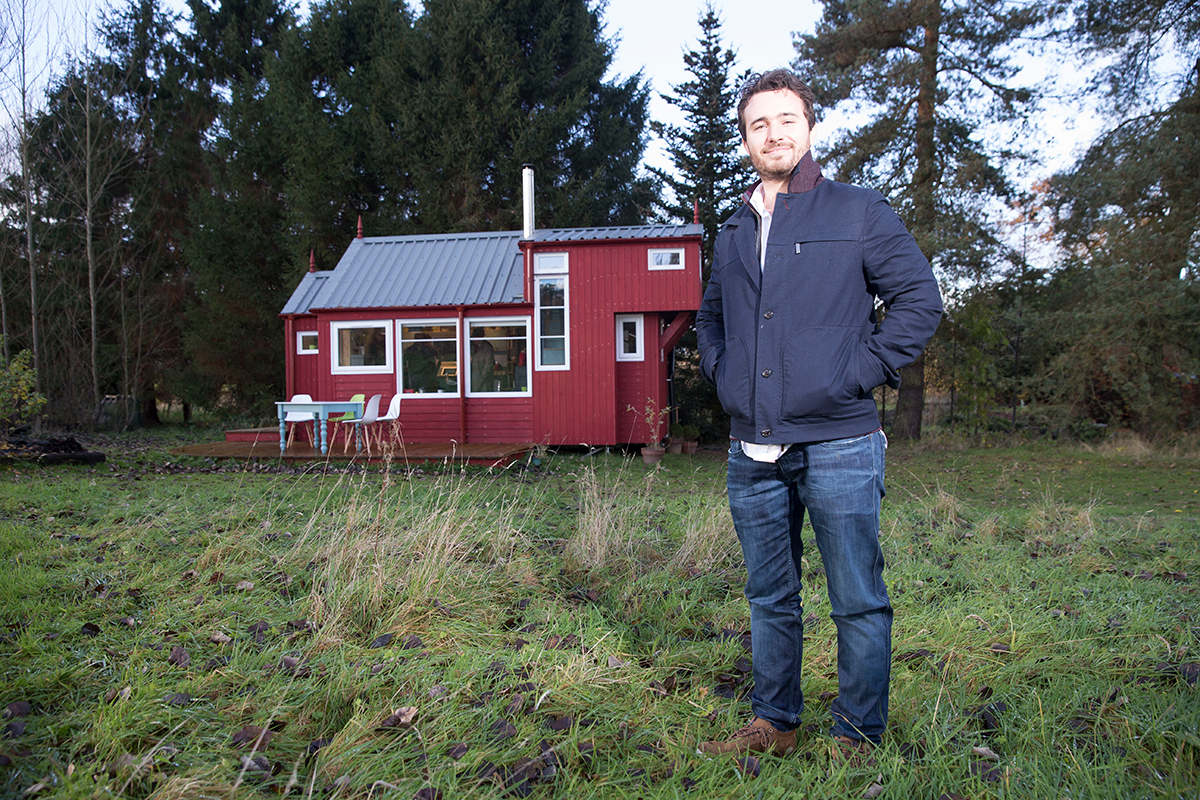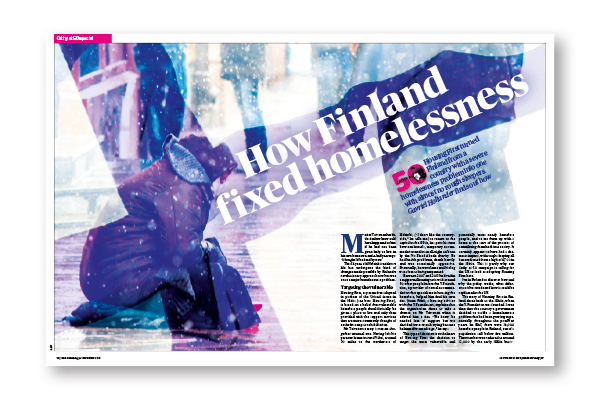You are viewing 1 of your 1 free articles
Housing First: a new look at the evidence
Martin Hilditch looks at a new report commissioned because of a charity’s concerns Housing First risked oversimplifying thinking about how to tackle homelessness. Picture: Getty
Housing First is an approach to tackling homelessness that burst into the mainstream in the UK in 2017.
It had proved successful in other countries and had been adopted in a piecemeal, low-key way by some charities and housing providers in the UK prior to last year.
At its most basic, Housing First flips the traditional UK homelessness model on its head and offers homeless people permanent housing alongside intensive support to help maintain the tenancy, rather than forcing them to jump through hoops before they are deemed ‘housing ready’.
In 2017 it was suddenly an approach everyone was talking about. At the start of the year Inside Housing called for the government to support Housing First projects, collect evidence and distribute best practice as part of its Cathy at 50 homelessness campaign.
By the time of June’s general election all the main political parties in England had backed the approach in one shape or another, with the Conservative Party pledging to pilot a Housing First approach to tackle rough sleeping. Towards the end of the year, Theresa May’s government announced it would provide £28m to fund three regional Housing First pilots.
Earlier this year the Welsh Government said it would bring forward a nationwide Housing First programme and in Scotland the cross-party Local Government and Communities Committee has called for its introduction.
However, amid all the activity, some people in the homelessness sector were becoming concerned that Housing First was being presented as the single answer to tackling rough sleeping.
As Dominic Williamson, executive director for strategy and policy at homelessness charity St Mungo’s, puts it in an exclusive comment piece for Inside Housing this week “we were becoming concerned that the story being told to promote the approach was too simplistic” – for example, in looking at outcomes it achieved when compared with ‘poor quality’ hostel accommodation in other countries.
In a bid to address these concerns and inform further discussions about the approach taken in the UK, St Mungo’s commissioned research by the University of York to review a range of Housing First research from across the UK, Europe and America. The findings of that research are now being published for the first time.
The big question, of course, is what did the research conclude about Housing First? Are governments, councils and housing providers across the UK approaching things in the wrong way and how should this new report inform their thinking?
The first thing it is important to make clear is that the report doesn’t seek to sound the death knell for Housing First. In fact, its headline conclusion is that it is highly effective in ending homelessness among people with high and complex needs.
It does sound a note of caution, however, about presenting it as a solution to single homelessness or rough sleeping by itself.
Overall, the report, by professor Nicholas Pleace from the university’s Centre for Housing Policy, concludes that the evidence shows it needs “to be part of an integrated homelessness strategy to be truly effective”. In effect, he argues this means deploying Housing First alongside a range of tools, such as preventative services and other forms of floating support.
Click here for more about how Housing First was effective in Finland
Professor Pleace’s evidence review suggests that Housing First services perform well against “inflexible, abstinence-based services that attempt to end homelessness by making someone ‘housing ready’ before they move into their own home”. It finds that there are good reasons to employ the approach as a means to reduce single homelessness among people with high and complex needs.
However, it warns against assuming that research on Housing First carried out in other countries can be directly applicable because UK accommodation-based approaches and floating support can have more in common with Housing First than existing services with which Housing First has been compared in North America and Europe.
“You will hear some concerns that some schemes in the UK that call themselves Housing First have drifted too far from the original principles.”
“When Housing First is described as ‘ending homelessness’ as it often is, this really means a range of services with different levels of adherence to the original model and – importantly – very different levels of resources and different client groups,” the report states. “An Italian Housing First service, as has been the case with British Housing First services, is a small team of Housing First workers providing intensive support to people living in the most suitable and affordable housing available.”
It says this is different to “the interdisciplinary teams, medics, addiction specialists, mental health specialists and social workers educated to postgraduate level” found in Housing First services in the US, Canada or France.
Speak to homelessness charities in the UK, and you will hear some concerns that some schemes in the UK that call themselves Housing First have drifted too far from the original principles (for example, by not providing tailored support to individuals).
The key Housing First principles can be found on the Housing First England website, and are summarised here:
Housing First: The seven key principles
- People have a right to a home so Housing First prioritises access to housing as quickly as possible without any conditions other than the willingness to maintain a tenancy. Individuals won’t lose the tenancy if they disengage from or no longer require support.
- Flexible support is provided for as long as it is needed with housing providers committing to long-term, flexible support without a fixed end date.
- The housing and support are separate – so housing is not conditional on engaging with the support. The offer of support remains if the tenancy fails.
- Individuals have choice and control. They have the choice, where possible, about where they live. Accommodation should be pepper-potted and self-contained, unless an individual says they would prefer shared housing.
- Active engagement. Staff proactively engage clients and caseloads are small. Support provided as long as clients need it.
- The service supports people to identify their strengths and goals and to develop skills and knowledge to achieve them.
- A harm reduction approach is used – so individuals who, for example, self-harm are supported to undertake practices which minimise the risk of them self-harming.
Source: Housing First England
Professor Pleace’s research confirms that sticking closely to these principles appears to be important. “There is evidence that adherence to a set of core principles has generated consistent success in ending homelessness across a range of countries, but there have been cases where services calling themselves Housing First have drifted some distance from the core philosophy,” the report adds.
The report warns against “any temptation to simply replace service models that are already in place with Housing First” without properly considering the strengths of the existing services and whether a change would be the best way to prevent and reduce homelessness.
“The report acts as a reminder that Housing First doesn’t exist in isolation.”
Overall, it concludes that understanding the reality of working services that are already in place, alongside proper comparative analysis, is vital to understanding the role Housing First can play moving forward in the UK.
Matt Downie, director of policy and external affairs at Crisis, which has backed the wider use of Housing First in the UK, said he agreed that “Housing First is not a silver bullet for resolving all forms of homelessness”. But he said Crisis remained optimistic about the impact it could have on homelessness in the UK and “how it demonstrates that housing-led approaches can be very successful in preventing and resolving homelessness”.
Overall, the report is broadly encouraging about the impact that Housing First could have in the UK. But it acts as a reminder that it doesn’t exist in isolation and that it is important to remain focused on looking at how its use can have the maximum impact on people’s lives.
Cathy at 50 campaign
Our Cathy at 50 campaign calls on councils to explore Housing First as a default option for long-term rough sleepers and commission Housing First schemes, housing associations to identify additional stock for Housing First schemes and government to support five Housing First projects, collect evidence and distribute best practice.















